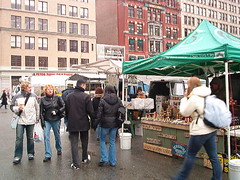Meet me at the intersection of the Greenmarket and Whole Foods
 The Union Square Greenmarket is the most bustling farmers' market in New York City. If there's local food to be found during any season, it's here. This past Monday boasted breads, apples, eggs, pies, wheatgrass, jams, and hydroponically grown greens. During the warmer months it's not uncommon to find story after story in the NY Times dining section chronicling big-name chefs' daily trips to the market or sharing new food fashions fresh from the farmstands.
The Union Square Greenmarket is the most bustling farmers' market in New York City. If there's local food to be found during any season, it's here. This past Monday boasted breads, apples, eggs, pies, wheatgrass, jams, and hydroponically grown greens. During the warmer months it's not uncommon to find story after story in the NY Times dining section chronicling big-name chefs' daily trips to the market or sharing new food fashions fresh from the farmstands. So it probably shouldn't have been such a surprise to find a sign across from the southern tip of the park, "Whole Foods: Coming March 2005." New Yorkers, after all, love Whole Foods and the image it sells. Though currently the only locations are in Chelsea and Columbus Circle, you'll find people proudly sporting the bags everywhere in town (and it's not as if the city suffers for health food stores).
So what will Greenmarket and Whole Foods cohabitation look like? Will it bring more people for the one-stop-shopping for all of their groceries? Or will Whole Foods' large-scale, cheaper, and often non-local produce/artisan selection siphon off customers from small-scale marketeers? Price wars between neighboring supermarkets are not exactly unprecedented, and I'm giving my vote for who will have the upper hand to Whole Foods.
Of course, it's not so simple. Whole Foods does try to stock locally when it's available, though they don't always try all that hard considering the price that they offer to farmers. And while many are staffed by family farmers who already have a tough time making ends meet, some stands at the Greenmarket clearly use the nostalgic-factor to exploit consumers (and the market has recently had some of its own issues). More grocery shoppers in Union Square would mean more buyers for farmers, and the expanded access and affordability of local produce is good news for consumers. Beyond money, you still can't go into a Whole Foods and find out about the growing history and flavor of the squash you're about to buy from the person who picked it off the vine.
It's still up in the air which canvas bag will be the one to be seen this summer.
0 Comments:
Post a Comment
<< Home